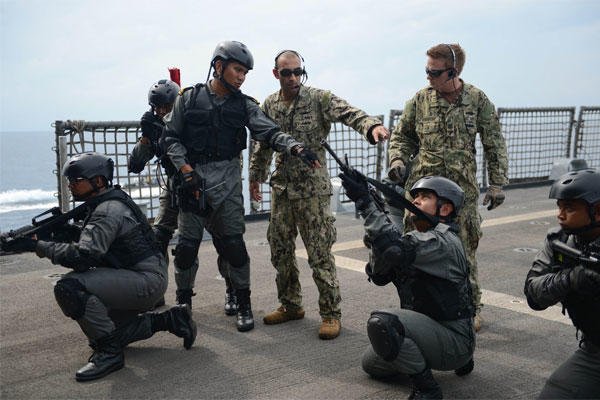SOUTH CHINA SEA -- Sailors assigned to USS Freedom's (LCS 1) visit, board, search and seizure (VBSS) team conducted a boarding exercise with the Royal Malaysian Navy Sept. 4 as part of Southeast Asia Cooperation and Training (SEACAT) 2013.
Freedom is one of three U.S. ships along with a P-3C maritime patrol aircraft participating in the exercise.
"Freedom is a great fit for an exercise like SEACAT that focuses on maritime security and boarding scenarios - capabilities that are part of the surface warfare mission package," said Capt. Paul Schlise, commander, Task Group 73.1/Destroyer Squadron (DESRON) 7. "Having Freedom as a dedicated SEACAT asset while the ship is already deployed in the region is a huge value for this multilateral exercise."
SEACAT highlights the value of information sharing and multilateral cooperation in scenarios that give participating navies hands-on practice in maritime security operations. The two-week exercise began Sept. 2 at Singapore's Changi Naval Base where liaison officers from Brunei, Indonesia, Malaysia, the Philippines, Singapore, Thailand and the United States began working together to track vessels of interest and develop boarding plans. The boarding events occur in several at-sea locations across maritime Southeast Asia with naval assets from each participating nation.
In the first boarding event of SEACAT, a team from the Royal Malaysian Navy ship KD Pahang (171) boarded Freedom. After completion, Freedom's VBSS team had an opportunity to board Pahang. Evaluators from the U.S. Navy Maritime Civil Affairs and Security Training (MCAST) team supervised both teams and provided hands-on training in boarding techniques and procedures.
"We are very appreciative of the training we received from the Freedom," said Sub-lieutenant Wan Akmal Zaki, a boarding officer from Pahang. "The greatest benefit from this training is being able to apply our differences in culture, environment and communication as a training element to prepare us for the challenges of compliant boardings."
During the exercise, participants went through and secured engineering and bridge spaces and searched for pre-staged personnel who acted as suspects. The MCAST group divided participants into bridge, engineering and sweep teams, and set up unpredictable scenarios to challenge both the Malaysian and U.S. groups.
"The Malaysians conducted boarding differently than we do," said Chief Fire Controlman Benjamin Carroll. "But the differences helped reinforce our baseline tactics and we were able to learn different techniques that we never thought of before - that training is very valuable."
After the boarding events were complete, both teams met on Freedom to exchange best practices and lessons learned.
"It was a great experience to be able to board another county's ship," said Fire Controlman 1st Class Darrell Caudill. "There is no better training than facing real life challenges. Encountering the unfamiliar brings new tests and new ways of thinking."
As SEACAT continues through Sept 12, Freedom will participate in more boarding events. The exercise is one of the key engagements with regional navies during Freedom's maiden deployment to Southeast Asia. Since arriving in the region, Freedom has also participated in Singapore's International Maritime Defense Exhibition, and two phases of the bilateral exercise Cooperation Afloat Readiness and Training (CARAT) - CARAT Malaysia and CARAT Singapore.
























